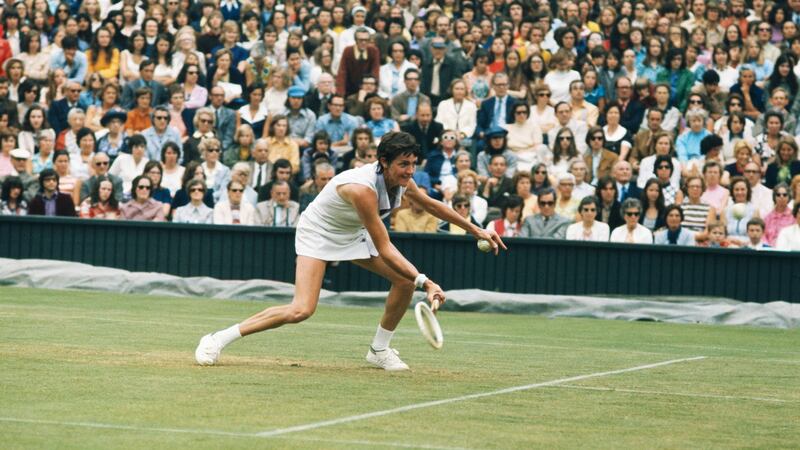There’s a certain irony now that in her autobiography published last year Margaret Court classed herself as the “anonymous champion” who, despite a spectacularly successful tennis career that saw her win a record 24 Grand Slam titles, is rarely ever mentioned when it comes to debates about who was the greatest female player of them all. “Casual fans,” she wrote, “could be excused for not even knowing that I exist’’.
They most likely know of her existence now.
The 74-year-old, a Christian pastor at a Pentecostal church she founded in Perth back in the 1990s, has been at the eye of a particularly turbulent storm since the West Australian newspaper published her open letter to the Dublin-born chief executive of Qantas airlines Alan Joyce, an openly gay man who has been a vocal supporter of marriage equality.
“I am disappointed that Qantas has become an active promoter of same-sex marriage,” she wrote. “I believe in marriage between a man and a woman as stated in the Bible. Your statement leaves me no option but to use other airlines where possible for my extensive travelling. How proud I was to promote the kangaroo tail throughout the world . . . but unfortunately no more. I love all people and will be pleased to talk to your board at any time. But it won’t be in the Qantas lounge. God bless.”
Hitler
The ensuing uproar served merely to embolden Court, rather than quieten her. A few days later she even brought Hitler in to it when she spoke to Vision Christian Radio, reckoning that ‘homosexual tendencies’ in young people were simply the work of the devil. “That’s what Hitler did. That’s what communism did,” she said, “get in the minds of the children. There’s a whole plot in our nation and in the nations of the world to get in the minds of the children.”
By now, those who had earlier defended her right to free speech on the issue were probably more inclined to say, ‘ah strewth, Marg’.
She wasn’t finished. Tennis today, she went on, “is full of lesbians”, compared to her day when there were only “a couple”. “But those couple took young ones in to parties and things. And you know, what you get at the top is often what you’ll get right through that sport.”
She didn’t actually name Billie Jean King and Martina Navratilova, but their ears were possibly burning.
In response to it all, Navratilova led the calls for the Margaret Court Arena at Melbourne Park – home of the Australian Open – to be renamed.

Among those opposing the suggestion was Australian Prime Minister Malcolm Turnbull who insisted that her personal views were irrelevant, the arena simply “celebrates Margaret Court the tennis player”.
Court herself echoed that particular view. “I think it’s very sad that they’re bringing my tennis in to it . . . it’s bullying,” she said, even though her letter to Joyce had opened with reference to her achievements in the sport. So, she’d left herself exposed at the net on that one.
But she has expressed these views for decades, and other equally controversial ones. When, for example, Arthur Ashe was refused a visa to play in South Africa because of the colour of his skin, she said: “If you ask me, South Africa has the racial situation rather better organised than anyone else, certainly better than the United States.” When she was interviewed by Rod Quinn on Australian radio last year about the issue she referred to “the coloureds” of South Africa. Unreconstructed, you might say.
Revolutionary
It was a fascinating interview too, revealing a woman who now seems so lost in time to have been way ahead of it during her playing career. “The press called me the Aussie amazon because women didn’t do that back then,” she said of her five mornings a week in the gym, lifting weights and the like. She was up at 4.30 in the mornings “running the streets” with Dobermanns chasing her, she said, all in the pursuit of making herself as fit and strong as she could be. That, in women’s tennis at the time, was revolutionary.
She drew the line at all that ‘women’s lib’ lark, though. When she played Bobby Riggs in 1973, a match that prompted his famed ‘Battle of the Sexes’ contest with King later that year, she insisted she did it purely for the $10,000 cheque, and not to strike a blow for female tennis. King pleaded with her to prepare properly for the match. She didn’t, and lost in straight sets.

She was aware of the inequality in her sport, too. When she won her first Australian Open title, in the amateur era, her prize was, comically, an umbrella. After her second success, she was awarded a cosmetic case. “But it was empty!” The same year, Roy Emerson was given a silver tea service for winning the men’s title. “I just thought, that can’t be right,” she said, but she wasn’t going to start campaigning about it.
In that autobiography, Court wrote about her mother who, after those rare occasions Court lost a match, would say to her daughter: “Are you coming home now?” She never wanted her out in ‘the big bad world’. Her mother was, she said, so strict a Catholic she was “scared of life to the point of paranoia”.
It might be argued that Court has inherited those genes, if of a Pentecostal rather than a Catholic hue.
The petitions will continue to gather signatures apace, but it might be best to leave her name on that Arena, to serve both as a monument to her achievements as a player and to the views she now expresses. A reminder, maybe that both belong in the past.











